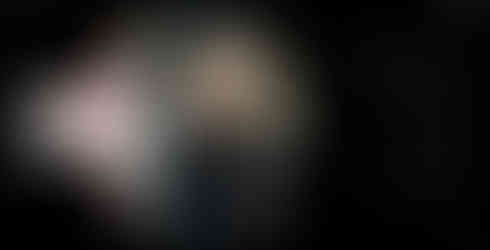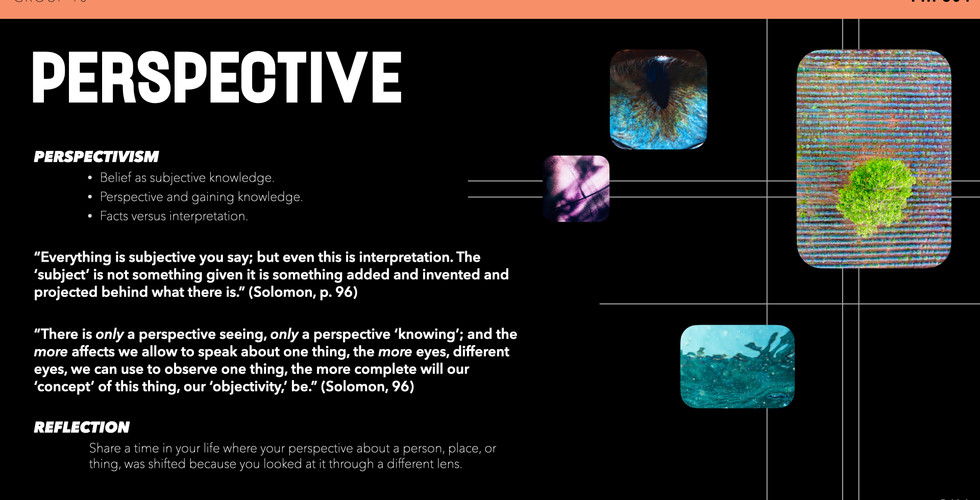Presentation | Nietzsche and Perspective
- Robyn Norrah

- Oct 13, 2022
- 2 min read
Updated: Nov 21, 2022
For ASU's PHI 304: Existentialism, we were assigned groups tasked with presenting various philosophical works. I lead my group in exploring selected pieces from Friedrich Nietzsche's Twilight of the Idols and On Truth. We opened with a video that posed relevant questions to the text and collected videos to guide introspective thinking. I designed the slides in our presentations, working closely with each peer to discuss their topic and process. Below the slides is a sample of one of my lectures which was on slide ten and covers "The History of an Error" through graphic design and visualization.
Introductory Video: "Perspective"
The introductory video was written, shot, and edited by me (with the help of my cat, LaCie!). It uses video from multiple sources, such as National Geographic and Pexels. The background music is titled "Airplane Mode (Instrumental)" by Limbo.
Presentation: "Friedrich Nietzsche"
Lecture: "The History of an Error"
Below is the lecture I correlated to slide ten in the above presentation. Professor Botham inspired us to be as creative as Existentialists are on our projects. In response, I aimed to use symbolism in graphic design to embody Nietzsche's "History of an Error" in On Truth. My peers responded to this section by offering their interpretations and perspectives on the imagery, the textual context from our course book, and their personal experiences.
Script
In the final part of the reading, “How the ‘true world’ finally became a fable” or “the history of an Error by Nietzsche. We have a six-part description of how an error comes to realization and later ceases to exist. Nietzsche uses an immense amount of symbolism to demonstrate his ideas, so we’ve used images in an attempt to encapsulate his thoughts and are interested in listening to your interpretations!
Lets dig in:
The first order nods to a true world, using abstract concepts of sage wisdom, piousness, simplicity and persuasion. There’s virtue and it’s reflective: “I, Plato, am the truth.”
Then this true world becomes inaccessible to sinners who do not repent. Idea progresses to incomprehensible — truth “becomes female” and “christian.”
The third stage introduces an old sun, “but seen through a mist of skepticism.” Ideas seem to become real, reasoned, defined, and outlined. Kantian.
In the fourth, the true world is attained in its uncertainty. Yet, how could something unknown obligate us? A gray morning, a paradox, positivism that rests between knowledge and a guess. The eye is lazily open.
The “true” world then adapts to only an idea by the fifth stage, while the symbolism becomes increasingly more physical. Bright day, breakfast, or Earthly needs and desires, Plato’s embarrassed blush, a pandemonium of all free spirits. There is chaotic and jovial energy that is deeply rooted in an untethered nature. Finally, the true world is abolished, but for a blink. At high noon, the moment of the briefest shadow. By erasing what’s true, reality itself drops its illusion.
This aspect of Nietzsche's work felt incredibly metaphysical to me. He seems to not just be describing truth but the nature of existence itself. I derived a lot of symbolism from Taoist philosophy in this analysis. It’s unknown if Nietzsche was ever impacted by the works of Laozi, but the imbalance and flow of harmony feel similar to ideas attached to the symbol of yin and yang. Yin symbolizes the unknown, receptive and intuitive energy. It’s ethereal and holds night, chaos, abstraction, and femininity. Yang represents the known and seen. It’s active and holds daylight, order, logic, force, and masculinity.
I saw these ideas presented at the beginning, where descriptors appear as one note and of mental quality. I saw these ideas presented at the beginning, where descriptors appear as one note and of mental quality. By the final stage, we get a sense that the physical cannot exist without the mental. The truth depends on someone to define it and seek it.
But there is a kind of emptiness in this task. In a similar quality, to live without might be as close to devoting one's life as a Buddhist monk. Clearing the mind, the minds-eye and any Earthly desire to be anything more than simply a part of Earth. However, I don’t think Nietzsche wants to leave us with a solution but rather something to puzzle over. Where do we go from here? Is an anti-true world worth pursuing, or is there a way we come to understand the truth and dismantle the effects and projections of historical assumptions on our lives? Can we unshackle ourselves? Is it even possible? Worth it?
Our group received high marks for this project, with myself receiving an A+. Professor Botham's course style was incredibly inspiring, allowing us to breathe out our words instead of tightening them up into essays. I am grateful for his ingenuity and for having had the experience of presenting philosophical work as a lecture through my undergraduate coursework! This course taught me more than existentialism, it taught be how to infuse my skills in digital marketing and design into my philosophical prowess. I look forward to seeing how I apply the combination of these skills into the future!























Comments